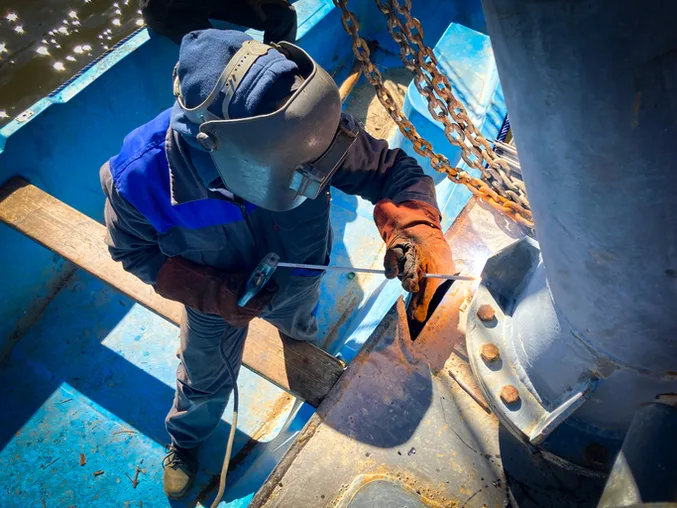
All jobs on an offshore oil rig come with risks. However, for those working under the ocean, the dangers increase substantially. Underwater welders and divers keep oil rigs operational. But they are the ones who must descend hundreds of feet underwater to inspect and repair rigs, pipelines, and subsea equipment when something goes wrong—often in near-zero visibility and under extreme pressure.
Despite the critical nature of welders’ work, serious injuries and fatalities rarely make the news. But make no mistake—these workers face life-threatening hazards every time they enter the water.
Read on to learn about the dangers of underwater welding and how our undefeated offshore injury lawyers hold the companies who cut corners and put divers’ lives at risk fully accountable.
What Does an Underwater Welder Do?
An underwater welder dives hundreds of feet below the surface to perform their work. Generally, welder divers work with a team of individuals who monitor and assist with various aspects of the job.
Underwater welders can work on oil rigs and pipelines. They may also work in other industries that require underwater welding, such as on bridges, dams, and sewer lines. Some work offshore, while others work onshore. Welders may perform inspections, construction, repairs, and salvage work.
Underwater welders often use waterproof electrodes to perform wet welds. However, hyperbaric welding projects require a habitat to be constructed that covers the worksite to allow the welder to perform dry welding, which is more precise than wet welding.
The habitat expels the water, allowing the welder to use a welding hood and breathe the air inside the chamber while working. Some workers may live in hyperbaric chambers for weeks at a time to stay at the pressure they need to work to avoid the time-consuming task of returning to the surface at the end of each day.
Dangers of Underwater Welding
All types of underwater welding are dangerous. Welders who work on offshore oil rigs face the dangers of underwater welding combined with working under the ocean on an offshore oil rig.
Risks faced by underwater welders include, but are not limited to:
Drowning
Many things can go wrong underwater that could cause a welder to drown. A depleted or damaged air supply can result from:
- Entrapment from equipment
- Severe injury that prevents the diver from returning to the surface before running out of air
- Air supply failures from cut or pinched hoses, defective equipment, malfunctions, etc.
- Cords that break or become tangled
- Differential pressure hazards
Backups and safety measures should be in place to prevent a diver from running out of oxygen. However, things can go wrong very quickly underwater, which could result in an underwater welder drowning.
Explosions
Welding produces temperatures of 10,000 degrees Fahrenheit or hotter. At these temperatures, hydrogen can split from oxygen. An electrode can cause an explosion if the hydrogen builds up and adds to the gases or fumes from the oil rig.
Other Dangers and Risks Faced by Underwater Divers
Welding is a dangerous profession. Combine that danger with oil rigs and being underwater, and numerous things can go wrong. Other things that can cause injuries and death for underwater welders include:
- Nitrogen narcosis
- Hypothermia
- Decompression sickness
- Electric shock
- Arterial gas embolism
- Oxygen
- Rough water and strong currents
- Sea life, including sharks, stingrays, and jellyfish
- Falling equipment
The unknown is one of the worst parts of underwater welding jobs. Companies and workers take precautions to avoid accidents and situations that could cause injuries and death for oil rig welders. However, anything could happen when working underwater, especially in the middle of the ocean. Planning for everything that could happen when someone is underwater working on an oil rig is impossible.
Who Is Responsible for the Safety of Underwater Welders?
Underwater welders rely on their employers and their teams to keep them safe when they are below the water’s surface. Employers should provide the equipment necessary to keep welder divers safe. They should implement emergency and safety procedures and ensure those plans are followed to protect underwater divers.
State laws may regulate some aspects of underwater welding. OSHA has some regulations that are specific to commercial diving. There may be federal laws that apply in some underwater welding accidents. Unfortunately, there is not much oversight and enforcement in this area. Therefore, welders and their families must fight to prove who is to blame for a welder’s injuries or death.
Contact the Undefeated Midland Offshore Oil Rig Accident Attorneys from Zehl & Associates Injury & Accident Lawyers for Help Today, Call (888) 603-3636
With Billions won, our undefeated oil rig accident lawyers have recovered the largest, record-setting verdicts and settlements for injured offshore workers across Texas, Louisiana, and the United States. Whether your claim falls under the Jones Act, DOHSA, or General Maritime Laws, our legal team will devote whatever resources are necessary to ensure that you and your family receive the maximum compensation possible.
If you or a loved one were injured offshore, call (888) 603-3636 or fill out our Contact Us form for your free case review.
For more information, please contact our undefeated oil rig accident attorneys in Midland at Zehl & Associates Injury & Accident Lawyers to schedule a free consultation today.
We proudly serve Harris County, Midland County, and throughout the state of Texas. We are located in Houston and Midland and throughout the state of Texas:
Zehl & Associates Injury & Accident Lawyers – Houston
2700 Post Oak Blvd #1000, Houston, TX 77056
(888) 603-3636
Open 24 hours

Zehl & Associates Injury & Accident Lawyers – Midland
306 W Wall St Suite 701, Midland, TX 79701
(432) 220-0000
Open 24 hours